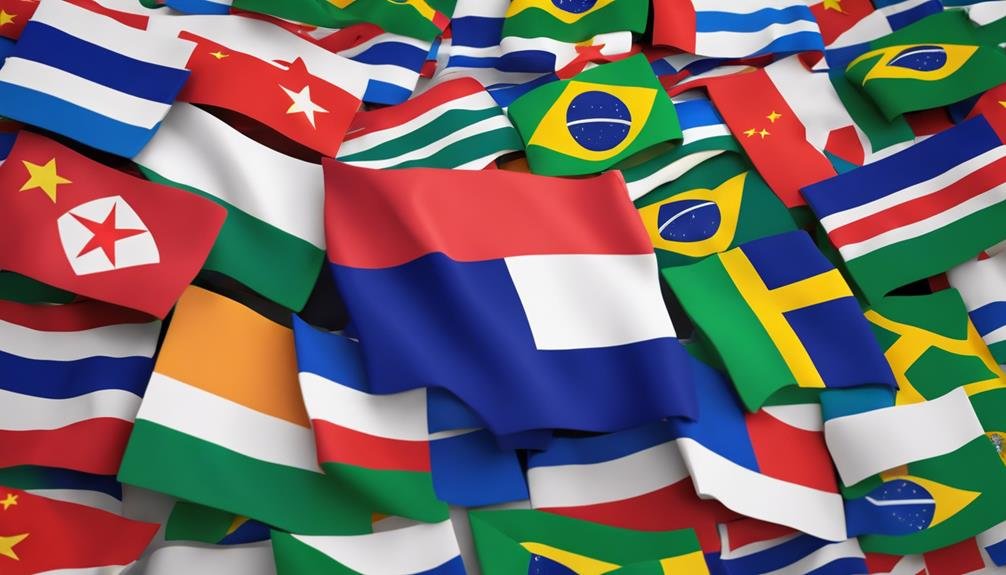BRICS: Acronym for Brazil, Russia, India, China, and South Africa
BRICS, comprising Brazil, Russia, India, China, and South Africa, forms a strategic alliance focusing on economic cooperation and global influence. Established in 2006 and expanded in 2010, the group emphasizes enhancing economic ties, political coordination, and mutual growth. These emerging market economies collectively account for 31.5% of global GDP, playing a key role in shaping global economic and political affairs. Despite facing economic challenges, BRICS aims to solidify its position as a counterbalance to Western influence, emphasizing growth and collaboration. Learn more about BRICS' purpose, impact, challenges, and future prospects for maneuvering through the evolving global landscape.
Key Takeaways
- BRICS stands for Brazil, Russia, India, China, and South Africa.
- Established in 2006, South Africa joined in 2010.
- Focus on economic cooperation and global influence.
- Invited new members in 2023.
- Comprised of fast-growing emerging market economies.
BRICS Formation and Membership
The establishment of the BRICS group, comprising Brazil, Russia, India, China, and South Africa, marked a significant milestone in global economic cooperation and strategic partnership. Formed in 2006, the alliance aimed to enhance economic cooperation and global influence among its members.
South Africa joined in 2010, expanding the group's reach and influence. In 2023, BRICS invited new members, indicating a potential for further growth and diversification. The history of formation showcases a commitment to fostering collaboration and mutual development.
As the alliance continues to evolve, membership expansion remains a key aspect to enhance the collective strength of the group and broaden its impact on the global economic landscape.
BRICS Purpose and Objectives
An examination of BRICS' purpose and objectives reveals a strategic focus on fast-growing emerging market economies and joint priorities aimed at enhancing economic cooperation and global influence.
BRICS countries aim to strengthen economic ties through initiatives such as development financing, political coordination, and social and cultural exchanges. By leveraging their economic power, these nations seek to increase their political influence on the global stage.
Through cooperation and development, BRICS members aspire to build a platform for mutual growth and influence, countering Western dominance.
The group's collective GDP, accounting for 31.5% of the global GDP, underlines their significance in shaping the future of economic cooperation and influencing global policies to advance their shared interests in the international arena.
BRICS Evolution and Global Impact
Amidst shifting global dynamics, the evolution of BRICS nations continues to exert a substantial impact on the world economy and geopolitical landscape.
BRICS geopolitical dynamics have been shaped by their collective efforts towards enhancing economic cooperation and global influence. The nations have undertaken various BRICS development initiatives aimed at fostering cooperation, development financing, political coordination, and social and cultural exchanges.
As an informal confederation, BRICS counters the Western-led global order by emphasizing transparency and a balanced approach. Since their first official meeting in 2009, BRICS has attracted over 40 countries seeking to join, illustrating their growing influence.
This evolution highlights the group's significance in shaping global economic and political affairs through collaborative efforts.
BRICS Economic Challenges and Growth
Steering through economic challenges while aiming for sustained growth, BRICS countries face a pivotal juncture in their development trajectory. Despite their growth potential, these nations encounter various hurdles that impact their economic progress. One of the significant challenges includes a slowdown in growth post-global financial crisis, leading to decreased investor interest. Additionally, the closure of Goldman's BRICS Fund signifies a shift in perception towards these economies. To provide a clearer picture, the table below highlights key economic challenges faced by BRICS countries and emphasizes the need for strategic planning to guarantee continued growth.
| Economic Challenges | Impact | Solutions |
|---|---|---|
| Slowdown in growth | Reduced investments | Structural reforms |
| Decline in investor confidence | Economic instability | Diversification of markets |
| Infrastructure gaps | Hindered development | Increased investments |
| Income inequality | Social unrest | Inclusive policies |
| Environmental concerns | Sustainable development | Green initiatives |
BRICS Future Prospects and Influence
In contemplating the trajectory of the BRICS countries, a strategic analysis of their future prospects and potential influence reveals a complex interplay of economic dynamics and geopolitical strategies. As fast-growing emerging markets, the BRICS nations hold significant potential for shaping global partnerships and exerting influence on the world stage.
Their collective GDP, accounting for 31.5% of the global GDP, underscores the economic power they possess. By focusing on deepening economic cooperation and trade ties, these nations aim to solidify their position as a counterbalance to Western influence. The BRICS alliance, despite facing challenges, continues to seek avenues for growth and collaboration, emphasizing the importance of leveraging their combined strengths to navigate the evolving global landscape.
Conclusion
In conclusion, the BRICS coalition, comprised of Brazil, Russia, India, China, and South Africa, represents a significant force in shaping global economic dynamics.
Despite facing challenges such as growth deceleration and fluctuating investment appeal, BRICS continues to demonstrate rapid growth and emerging market prowess.
With a collective GDP share of 31.5% of the world's total, BRICS is poised to wield substantial political clout and play a pivotal role in shaping the global economic landscape.







